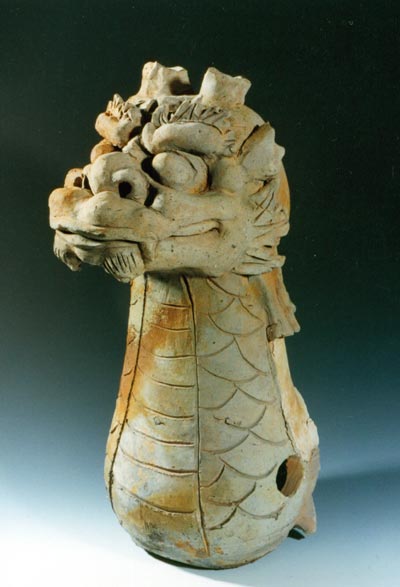It is the third big joint exhibition since Guangdong, Hong Kong and Macao established the system for their cultural cooperation in 2002. In the past 14 years, they have explored cooperation in six areas including performing arts, cultural information, museums, libraries, intangible cultural heritages' protection and the creative industry.
The first big joint exhibition was in 2006, displaying relics that incorporate both artistic styles in the East and the West and thus prove the cultural communication between China and the Western countries in ancient and modern times. The second was in 2012-13, taking visitors back to the glorious days of China when the exquisite art was exported to the West by seaway.
The latest and largest joint exhibition tells Lingnan's history over a wide time span from Neolithic times to the Qing Dynasty (1644-1911).
 |
|
A dragon-head architecture component of the Southern Han Dynasty. Photos Provided to China Daily
|
In the first section about the prehistoric age, the curator smartly categorizes the exhibits into four aspects-clothing, eating, housing and traveling-to give visitors an interesting glimpse of their ancestors' daily life. With detailed text illustrations, people will be amazed by their ancestors' wisdom of living. For example, sharpened pointed stones used as sewing needles.
Palaces in the Lingnan area started appearing in the Han Dynasty (206 BC-AD 220). In this section, the exhibition tries to "rebuild" the magnificent Nanyue Kingdom Palace with construction materials such as eaves tiles, furniture and decorations inside the palace and ceramic models that vividly reproduce the scenes in ancient people's lives, such as farming in the fields.
The third section unfolds the long history of Chinese china production, from the prehistoric age's crude pottery to the celadon and ceramic white ware in the Tang (AD 618-907) and Song (960-1279) dynasties and to the colorful china in the Ming (1368-1644) and Qing dynasties.
 |
|
A bronze pot of the Western Zhou Dynasty.
|
While marveling at the beauty of relics, visitors can also play the role of detective to trace evidence of the communication between Lingnan and the Central Plain in ancient times, which is fun, Chow Hing-wah, curator of the intangible cultural heritage unit of Hong Kong Heritage Museum, advises.
We Recommend:
